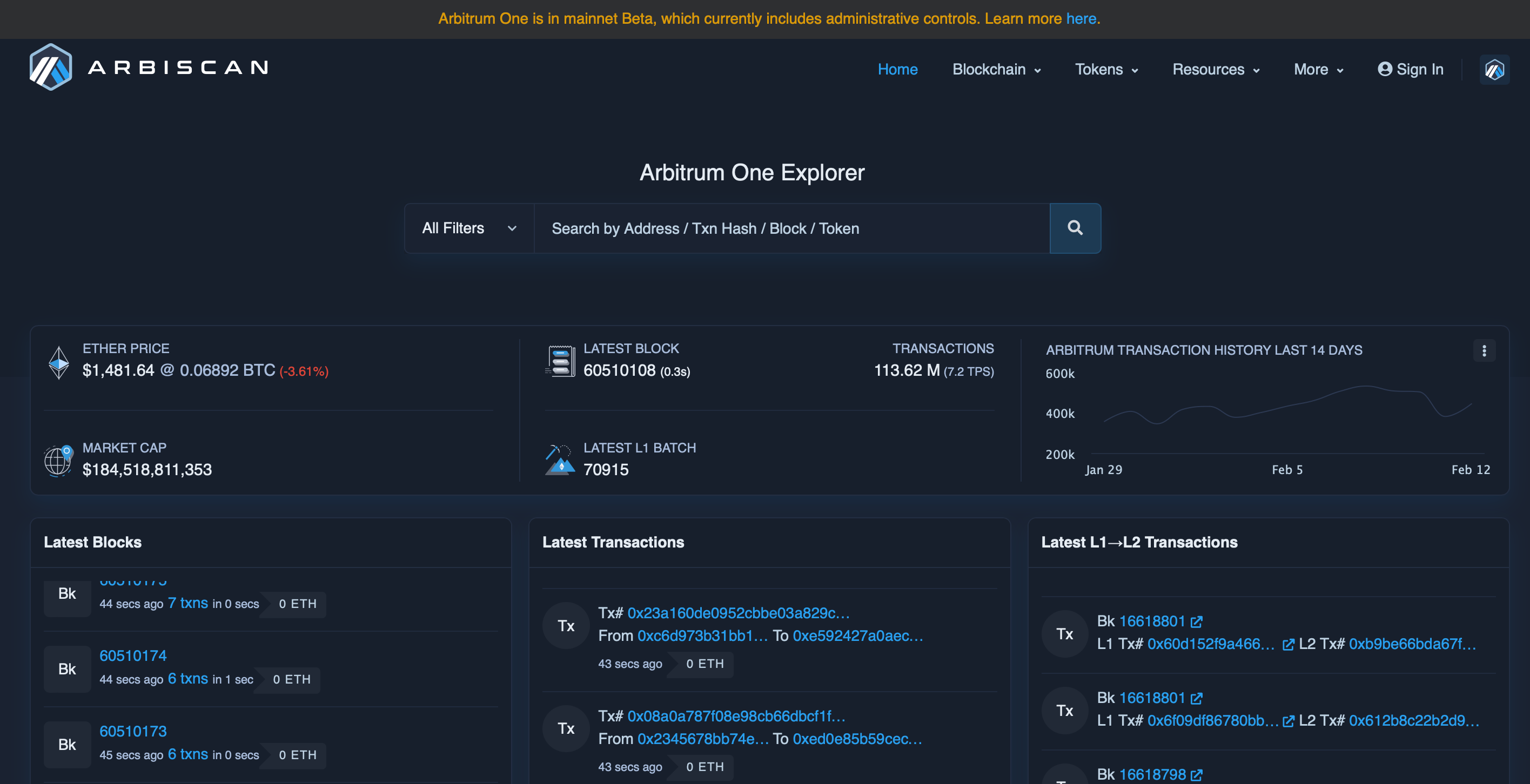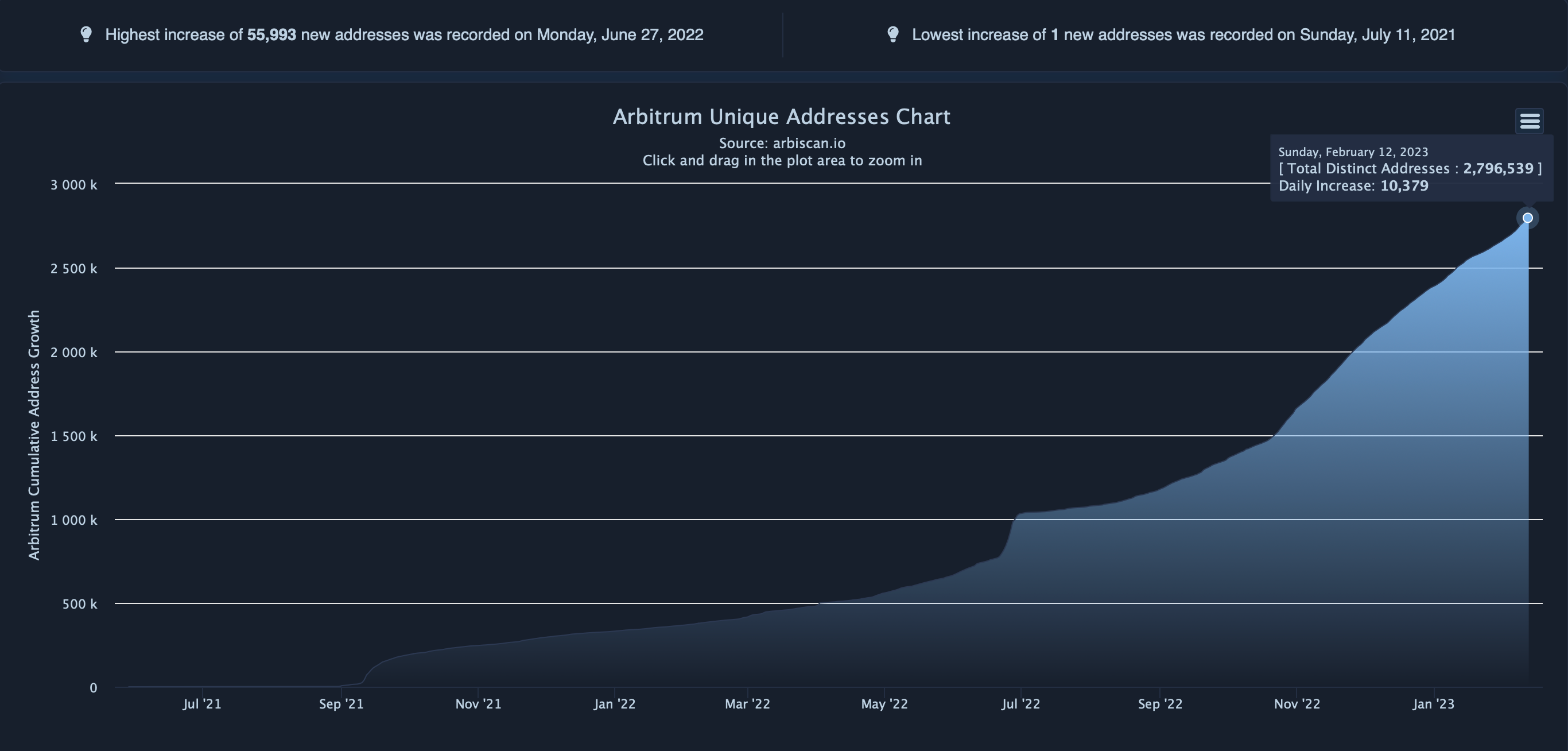Ethereum is limited in several areas, so layer-2 solutions exist to augment its weaknesses. Currently, there are layer-2 networks such as Polygon, xDAI, and Optimism. But a more prominent L2 scaling solution is gaining faster adoption in the industry - Arbitrum, a layer 2 chain with optimistic rollups and $1.4 billion in TVL.
What is Arbitrum?
Arbitrum is a layer-2 blockchain that facilitates a better user experience on Ethereum. It ensures a cheaper and faster throughput while leveraging Ethereum's security.
Offchain Labs - a team of reputable engineers with diverse backgrounds behind the protocol. Ed Felten, Harry Kalodner, and Steven Goldfeder founded Offchain Labs in 2018. The New York-based company researches various technological possibilities to enhance Ethereum performance and throughput. There are mainly two reasons why so many developers choose the Arbitrum network: faster transaction processing and lower transaction fees.
- Faster Transaction Processing. Today, Ethereum network operate under 15 to 20 TPS, a relatively low figure. The Arbitrum network presents a viable tech stack to skyrocket the performance of Ethereum. Analysis shows that it can conveniently process around 40,000 TPS.
- Lower Transaction Fees. A significant percentage of validators need to confirm the genuineness of a transaction before it can go through on Ethereum. This results in massive backlog in the mempool, with only a small slot being processed per instance. Hence, some traders often add additional fees to their usual gas fees, driving the cost of Ethereum transactions.
? Follow @hackenclub on Twitter
The Arbitrum network provides a cheaper option. According to Nansen, a Web3 data analytics firm, the average daily fee on Arbitrum was $.2, compared to $6.5 for Ethereum.
Arbitrum ecosystem
- DeFi and dApps
Decentralized finance is one of the significant areas where Arbitrum ecosystem is booming. The Arbitrum network is home to GMX, Buffer, and Kromatika, and 100 other crypto projects worth over $180 billion in total.
Arbitrum network has almost 100 decentralized applications, including blue-chip dApps, trading protocols, NFT marketplaces, DeFi projects, and Gaming projects. Examples include the most popular Ethereum dApps, such as OpenSea, Stargate Finance, and Uniswap. The huge user activities on these DApps have a corresponding effect on the overall user activity.
Crypto degens and retail investors are trooping to it because of the airdrops. A consistent pattern of the past months was that Arbitrumn ecosystem projects gave the most jaw-dropping airdrops.
- Insights Into Arbiscan

The first block explorer for contracts or transactions carried out is called Arbiscan. The second block explorer for smart contracts deployed with the Nitro Goerlione is Goerli Arbiscan.
Here are a few data that point to its strengths and fast-rising nature, according to Arbiscan:
- Processed up to 576,012 daily accepted transactions.
- Almost 3 million unique addresses.
- An average of 100 to 300 smart contracts deployment daily.

To a large extent, Arbiscan has a similar UI to Etherscan. Besides providing data on specific and generic transactions, Arbiscan also has a developer suite where developers can verify contracts and tap into its API and other functionalities.
How does Arbitrum Work?
Two Mainnets and One Testnet. Arbitrum network has two different mainnets and one testnet, unlike other blockchains that will have a single mainnet. Arbitrum One is the first mainnet, while Nova is the second. The Offchain Labs team introduced the Nitro tech stack in late 2022.
AVM architecture. Arbitrum is fully compatible with the Ethereum blockchain development environment and tooling. Solidity and Vyper developers can build smart contracts for Arbitrum bridge. They can also use frameworks such as Foundry, Hardhat, and Truffle. In essence, Ethereum smart contracts and Ethereum dApps work the same in Arbitrum network. It also has its virtual machine called the Arbitrum Virtual Machine. Offchain Labs built their custom AVM to solve the following three problems in EVM:
- Execution flow and structure . Arbitrum has an operating system at its core called ArbOs. The ArbOS ensures the solitary existence, optimal performance, and efficient analytics of smart contracts. Embedding such an OS into an L1 infrastructure cannot be cost-efficient and L2-native. This was why the Offchain Labs team engineered a custom virtual machine to host the ArbOs natively.
- Dispute settlement speed. When validators disagree, Ethereum virtual machine wouldre-execute the cause. But AVM has a custom protocol for dispute management, so that proving would not be carried out on a standard virtual machine. This is crucial for speed and maximal efficiency.
- Native tuples. The EVM necessitates any L2 to have its custom Merkle-hashing parameters. Arbitrum uses tuples to define and reference types in its Merkle tree. The tuples can be referenced in looking up the Merkle root of any transaction on the EVM Merkle tree. Due to its relativity to the EVM Merkle tree, the AVM became necessary since the tuple method will be native to it.
Turbocharging with the Nitro Stack
AVM architecture ends with the Arbitrum One network, otherwise called Arbitrum Classic. With the Nitro upgrade, the new generation of Arbitrum One mainnet utilizes WebAssembly.
Since H2 2022, Arbitrum One network runs with a Nitro stack under the hood. The Nitro update introduced geth and WebAssembly virtual machine. It was a paradigm shift for the Arbitrum bridge. No need for AVM anymore because WAVM can handle everything in a single instruction. Migrating to Geth has lowered the average transactional fees because all the interactions are done at a low level.
Arbitrum Layer-2 scaling solutions
Optimistic Rollup Stack
There are various scaling solutions: state channels, validium, sharding, and rollups. Rollups are scaling systems that bundle some transactions out of the main Ethereum network, process them off-chain, and integrate them back into the Ethereum state. There are different architectures for building a roll-up system, and the two most prominent methods are the optimistic method and the ZK method. The ZK method uses cryptographic proofs to ascertain the validity of transactions without displaying detailed data about these transactions.
Scaling solution
Arbitrum uses the optimistic roll-up method as a scaling solution, which assumes transactions are carried out validly until proven otherwise. It uses sequences to oversee the order in which transactions come into the core inbox. The Sequencer is a full Arbitrum node that links Arbitrum and the Ethereum network.
Arbitrum vs Optimism
Arbitrum can reach 40,000 TPS, way faster than its main competitor, Optimism, which can only process 20,000 transactions per second. However, Polygon is the fastest L2, as it can handle 65,000 transactions per second. But all the same, charts and data point to the Arbitrum platform as the second L2 in terms of speed.
What is the Arbitrum bridge?
Arbitrum Bridge allows users to transfer their assets from Ethereum. Of course, you must have the assets you want to bridge in your wallet.
Learn more about crypto bridges.
How to use the Arbitrum bridge?
For this tutorial, we will bridge some Goerli ETH tokens. When using a token bridge, ensure it's secure and credible, or you risk losing your private keys or token assets.
Steps to bridge tokens using the Arbitrum platform
Step 1: Configuring Your Metamask wallet
You will have to open your Metamask wallet, click on “Add a new network,” and fill in these details:
- Name: Nitro Goerli Rollup Testnet
- URL: https://goerli-rollup.arbitrum.io/rpc
- ChainID: 421613
- Symbol: GoerliETH
Step 2: Get Goerli ETH from Alchemy
Copy your Nitro Goerli address. Log in to Alchemy, paste your address in the inbox, and press “send" to transfer ETH tokens.
Step 3: Bridge the ETH from the Portal
Head over to Arbitrum Bridge and connect your wallet. Then select the asset you have and the chain you want to bridge to. In the instant case, choose Goerli to Arbitrum Goerli.
If you want real-time asset bridging to Arbitrum, configure your Metamask wallet to either Arbitrum One or Nova at Public Chains.
How To Deploy a Smart Contract on Arbitrum
Deploying smart contracts on Arbitrum is easy. Let's stick to the Nitro testnet.
- Configure your Metamask wallet to include it.
- After writing your smart contract in any EVM-compatible language, switch your “Environment” on Remix from Remix London to “Injected Provider - Metamask.”
- Conduct a professional smart contract audit.
- Click on deployment. Your Metamask wallet will throw a prompt, approve it, and your contract should get deployed on the testnet.
- Confirm the deployment by checking it up on Arbiscan.
Even though your codebase may look security-tight at first glance, it can still contain high-severity loopholes under the hood. Hacken is a trusted blockchain security auditor with 5 years on the market. We've audited 1,200 Web3 projects. In 2022, we reached a milestone of zero rekt cases. Your project will go through the most diligent code review and analysis by industry veterans who adhere to Web3 security practices. Leave no stone unturned.
Final Thoughts
Ethereum mainnet has been making significant progress as a main chain for digital assets with lower gas fees. Off-chain transactions are the future of blockchain technology. For Arbitrum bridge to succeed as a second layer in a sustainable way, builders must see it as a safe, healthy, and vibrant layer chain.
In the future, Arbitrum might have to focus on becoming a home for a specific niche of dApps and crypto projects. Arbitrum might also have to dip its feet into NFTs and bring mainstream businesses to the blockchain as Polygon does.



